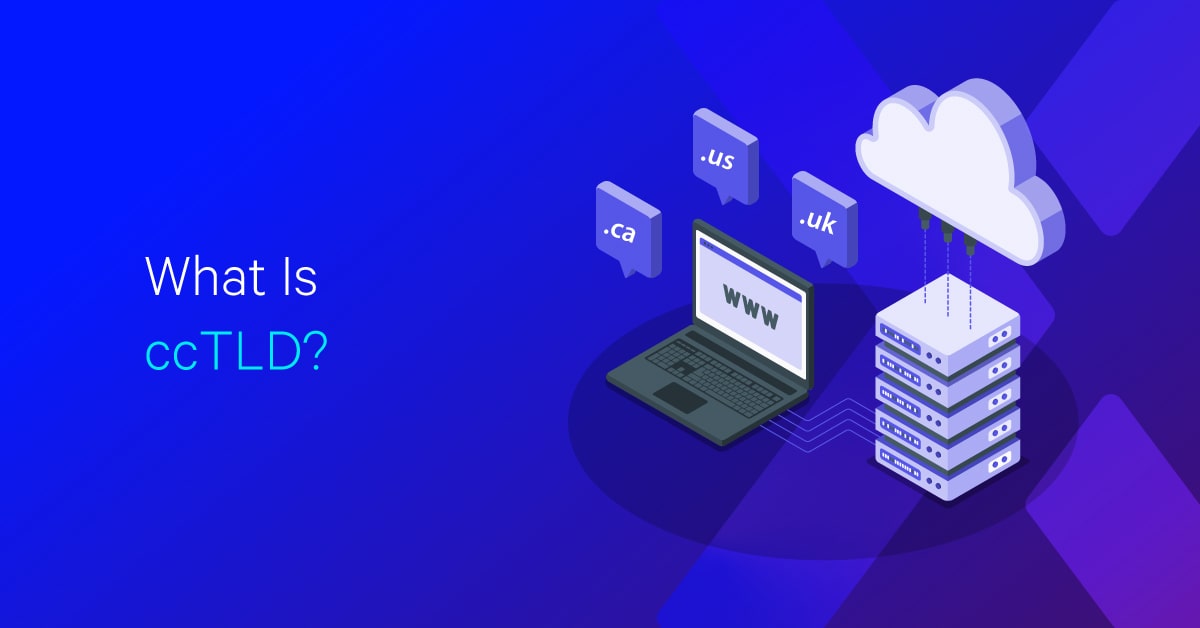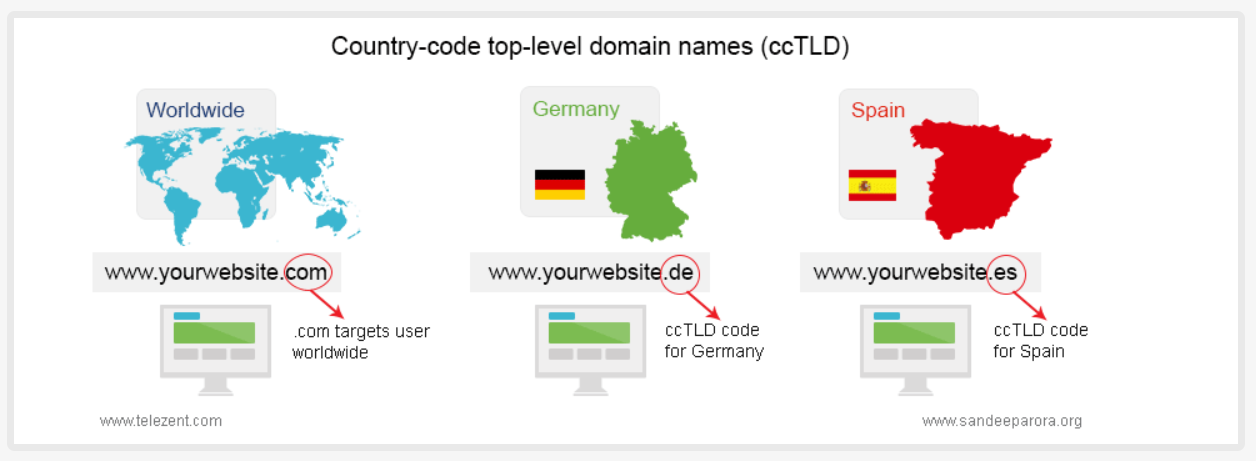What Is a ccTLD?

Hand off the toughest tasks in SEO, PPC, and content without compromising quality
Explore ServicesIs it necessary for your website to go international?
If you know that a sizable number of your website visitors come from countries other than your own, speak other languages, or both, it may be time to make some modifications to your website to give a better experience for all of your international visitors.
International SEO may appear to be a completely foreign concept on the surface, but you may be more familiar with it than you realize. Consider international SEO to be similar to geotargeting, except that instead of optimizing your website to attract traffic from your city or state, you optimize it for different countries and languages. For example, by researching Japanese keywords when optimizing for Japan, etc.
Important in international SEO, ccTLDs are the single most powerful way to show search engines and users that a site’s content is specifically targeted to a specific country or region — but, importantly, NOT to a specific language. When a site employs a ccTLD, Google assumes that the site (and all of its content) is specifically relevant to the geographic area targeted by the ccTLD and should appear on SERPs in that area.
In this article, you’re going to learn about Country Code Top Level Domains or ccTLDs, why ccTLDs are important, if ccTLDs affect SEO, and examples of ccTLDs.
What Is a ccTLD?
A Country Code Top Level Domain, or ccTLD, is an internationalized version of something you may be familiar with. Your perspective on this is influenced by where you are from, where you grew up, and where you have lived.
A country code top-level domain (ccTLD) indicates to users and search engines which country, sovereign state, or dependent territory a website is registered in — and, by extension, where in the world searchers who will find this site relevant live.
For example, if you are from the US. grew up in the US and, for most of your life, You’ve only seen “.com” domains. In Germany, “.de” is very common. In Australia, it’s “.com.au” or just “.au”. In Mexico, it’s “.mx”. In China, it’s “.cn”. In the United Kingdom, it’s “.uk”. In Canada “.ca”. While “.co”. Representing Colombia, “.eu”. for the European Union, In Switzerland, it’s “.ch”. and the list can go on.
Country code TLDs use ISO 3166-1 country codes except in a few rare cases where ASCII identifiers are used instead (for instance, .uk instead of .gb). TLDs with non-Latin characters are also available in some cases (including Arabic and Chinese) and are known as internationalized country code top-level domains (IDN ccTLDs or ccIDNs).
Websites can use DNSSEC internet standards to protect the domain name system (DNS) from manipulation, such as phishing websites that request sensitive data through fake web pages.
Below is a sample image showing ccTLDs:

Why ccTLDs are Important?
Google is a big fan of ccTLDs.
Google is a big fan of ccTLDs. It likes them so much that it has put ccTLDs at the top of the list of elements used to determine country targeting. Other localization hints, such as server locations and Geotargeting settings, can also help with country targeting, according to Google, but ccTLDs rank highest.
Remember that when targeting countries with ccTLDs, you don’t need to rely on Geotargeting – an international SEO tool that determines a web user’s location – which is generally more useful for websites using gTLDs (generic top-level domains) like .com or .net, which are not associated with any specific country. As a result, ccTLDs are an especially effective way to reach out to local audiences.
Customers recognize – and genuinely trust- ccTLDs
Aside from Google search benefits, another reason for using ccTLDs is that international users are already familiar with them. People, for example, have no trouble identifying .co.uk as an extension used to target either web users in the UK or users from other countries looking for UK-related content.
ccTLDs will create more opportunities for you on the Internet
Alternatives such as .nl and .fr help to create a less restrictive Internet for website owners while also allowing them to create a more impactful online presence. Just because the .COM domain you want is no longer available doesn’t mean you have to give up on matching your domain name with your company name, a domain name mistake you can easily avoid with the assistance of a relevant ccTLD. You can use WHOIS to find out if a domain name is available.
Finally, even if you’ve already registered a.COM, it’s a good idea to also register relevant ccTLDs to capture all of the online traffic generated by your brand name or keywords. It’s simple to forward one domain to another once you’ve registered multiple extensions. Essentially, ccTLDs will allow you to cast a global net, ensuring the greatest possible online presence.
ccTLDs FAQ
Does ccTLD affect SEO?
Using a ccTLD in your domain name does not affect SEO, and using a gTLD in your domain name does not guarantee that you will be ranked globally.
We all know that Google’s main goal is to provide relevant and useful information to its users. Using a ccTLD extension in your domain name assists Google in determining which country is more important to you. Using international domain extensions such as .com and .org does not guarantee that you will rank globally.
Google will attempt to understand your relevant audience based on your TLD and other signals such as IP address, page location information, and backlinks to the page, and will target them accordingly.
Let’s take Amazon as an example.
Amazon has different domain extensions for each country, which allows them to target their audience more effectively. Google follows suit, with different domain extensions for each country, such as google.co.in for India and google.fr for France. When you visit google.com, you will be automatically redirected to the country-specific TLD from which you are visiting. This is due to Google locating your country’s IP address and redirecting the user to the best local and relevant results.
What are ccTLD examples?
The country code TLDs, also known as country code top-level domains (ccTLDs), are domain extensions (the letters that appear after your preferred domain name) that are specific to a specific region or country. Here are some examples from IANA’s list of ccTLDs:
.fo (Faroe Islands), .hk (Hong Kong), .nz (New Zealand), .pr (Puerto Rico), .vg (Virgin Islands, British), .vi (Virgin Islands, U.S.), .wf (Wallis and Futuna), .my (Malaysia),
.ae (United Arab Emirates) .me (Montenegro), .za (South Africa), .ke (Kenya), .ac (Ascension Island)
An open ccTLD is a country-code top-level domain name that can be registered by anyone, regardless of where they live. Apart from the name of the country or territory they represent, these ccTLDs generally represent a specific branding opportunity to the registrants.
Examples include .cc (Cocos Island) for consulting firms, .tv (Tuvalu) for television tv domain, .ws (Western Samoa) for websites, and .co (Colombia) for companies as an alternative to .com. Demand Media and Verisign collaborated in 2006 to promote the .tv TLD as a preferred web address for media-rich content.
There are also restricted top-level domains (rTLDs), like .aero, .biz, .edu, .mil, .museum, .name, and .pro, that require the registrant to represent a certain type of entity or to belong to a certain community. For example names under gov.ccTLD come from authorized officials in government departments or that registrations in edu.ccTLD are only available to academic institutions in the country.
These definitions are courtesy of the Internet Corporation for Assigned Names and Numbers (ICANN). They have a division called the Internet Assigned Numbers Authority (IANA) who’s in charge of keeping and maintaining the official registries of gTLDs and ccTLDs.
ICANN-created registries and policies are put into action by gTLD registry operators, ccTLD managers, root-nameserver operators, and regional Internet registries.
Making Use of ccTLDs
Hopefully, this article has given you a better understanding of ccTLDs.
There is no doubt that registering the right ccTLD (country code domain extension) will bring numerous benefits, whether you are a startup or an established business looking to gain more online traction. With such a large number of ccTLDs available, you’re bound to find one, if not more than one, that works for you.
Special rules and requirements apply to these two-letter domain name extensions.
They differ greatly, that’s why Loganix is keen to help you implement terms of registration lengths and criteria, automatic renewal dates, domain name contact changes, and even transfer procedures.
It is critical not to underestimate the power of using a ccTLD to appeal to international customers. You will not only appeal to international visitors in a specific geographic area, but you will also have the potential for large returns and bringing in more customers.
Learn more about how we can assist you by clicking here!
Hand off the toughest tasks in SEO, PPC, and content without compromising quality
Explore ServicesWritten by Jake Sheridan on October 25, 2021
Founder of Sheets for Marketers, I nerd out on automating parts of my work using Google Sheets. At Loganix I build products, and content marketing. There’s nothing like a well deserved drink after a busy day spreadsheeting.





